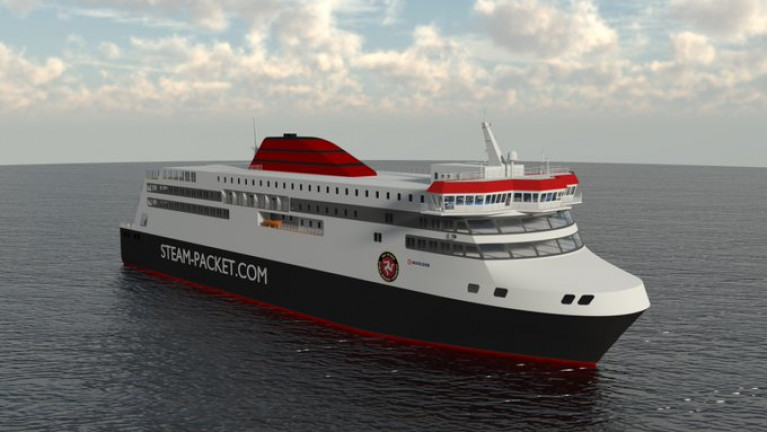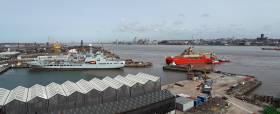Displaying items by tag: New RoPax
New Irish Sea Ropax Manxman to Get Original Art Work
Artists on the Isle of Man and island-based creatives are being given the chance to feature their art work in the interior of the newest ferry addition to the operator's Douglas based packet fleet.
The Isle of Man Steam Packet Company, in collaboration with SMC Art Consultancy, has announced it will be commissioning a collection of specially curated artwork to go on permanent display on board the new vessel, the Manxman.
Local artists have been invited to submit paintings and original artwork to the Steam Packet before Wednesday, January 26 to be considered for inclusion into the collection of work, which will ultimately be displayed in three different areas of the new ship, the pet lounge, the forward lounge and the first class lounge.
There is a brief available for each area, and artists may submit a proposal which covers all of the collection within an area, or they may submit a proposal which covers just part of the collection.
Manx Today has further details on the project's brief.
UK Shipbuilder On Merseyside to Reveal Plans for Innovative Ro-Pax Ferry at Norwegian Trade Fair
UK shipyard Cammell Laird on Merseyside will today announce at the Nor Shipping trade fair in Oslo, Norway ambitious plans to disrupt the new-build ferry market with a new specially designed Ro-Pax ferry.
Liverpool City Region based Cammell Laird is releasing a sneak picture preview of the commercial sensitive design ahead of a formal launch later this year. In addition the shipbuilder will be briefing prospective customers on the design at its stand (D06-15).
Cammell Laird’s project director Andy Askham said the company believes its innovative, environmentally ground-breaking design will prove attractive to an ‘underserved market’.
“The ferry industry is crying out for innovation and green-friendly solutions,” he said. “Our new Ro-Pax design will be in the segment of the market where there’ll be a lot of demand for the next decade. From our discussions with various owners we have seen real interest in our design that thrusts environmental innovation, fuel efficiency and comfort to the forefront of the future ferry market. The global ferry fleet is aging and in need of replacing while ferry building supply, certainly at a sophisticated level, is stretched in Europe in terms of spare capacity.”
Mr Askham said Cammell Laird will be marketing the Ro-Pax design based on its extensive experience and pedigree in the ferry market dating back decades.
“Owners have a degree of confidence in Cammell Laird following a series of new build jobs we have undertaken for the likes of Red Funnel and Western Ferries,” he said. “The Red Kestrel freight ferry we built this year for Red Funnel is a strong example of how Cammell Laird can build to a bespoke design. In addition, we are currently building the RRS Sir David Attenborough Polar Research ship, one of the most advanced vessels of its kind ever built. This showcases the incredible skills and expertise we have in the shipyard – and we won this ship and the Red Kestrel contract against fierce international competition. Cammell Laird can further demonstrate its expertise through the drydocking and repairs we undertake for many ferries each year for a wide variety of customers including Stena, P & O, Seatruck Ferries, Irish Ferries, Mersey Ferries, Calmac and the Isle of Man Steam Packet Company. We know the ferry market extremely well and believe it is ripe for a genuinely attractive new vessel design offering the most modern features.”
Mr Askham said Cammell Laird is working on the design now with an international design house ahead of the formal launch in planned for later this year.
New RoPax Vessels for Stena Line Beginning to take Shape
#FerryNews - An official keel-laying ceremony of a new RoPax for Stena Line took place at the AVIC Weihai Shipyard in China last Friday.
The traditional maritime event marks the start of the construction phase of the hull and the exterior parts of the vessel.
As previously reported on Afloat, the new RoPax vessels will be deployed on the Irish Sea and represent a key strategic investment to continue to further strengthen Stena Line’s business in the region.
“This is an important milestone in our exciting new ship building project”, said Niclas Mårtensson, CEO Stena Line, who also took part in the traditional Coin Ceremony where 4 coins (GBP, EUR, SEK and RMB) where placed under the keel-block as a symbol of good fortune.
The new vessels have a planned delivery timetable during 2019 and 2020. They will be 50% bigger than today’s standard RoPax vessels and this significant investment illustrates a continuation of Stena Line’s successful RoPax concept which mixes freight and passenger traffic as part of its operational business model.
“Our overall target is that these vessels will be the absolute state-of-the-art when it comes to energy efficiency, flexibility and customer service. In particular, we are placing heavy emphasis on developing a range of exciting new digital features which will provide our customers with unique additional services connected with their journey as well as developing a new, integrated digital onboard experience”, said Niclas Mårtensson.
“We have a positive outlook on the future and foresee continued growth within ferry transportation so this is an important strategic step in helping us to prepare our business to leverage that anticipated growth”, concluded Niclas Mårtensson.
Technical details of the new vessels:
Length: 214.5 m
Draught: 6.4 m
Breadth: 27.8 m
Car deck capacity: 3,100 lane meter + 120 cars
Passenger capacity: 1,000
Cabins: 175
Engines: 2 x V12 4-stroke diesel (2 x 12,600 kW)
Speed: 22 knots
Built: AVIC Weihai Shipyard, China































































